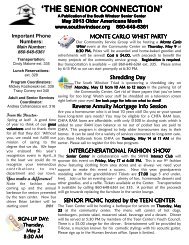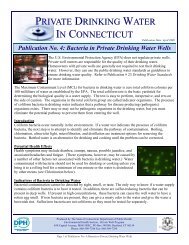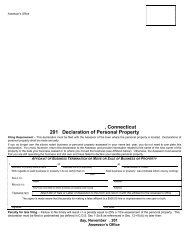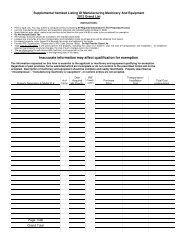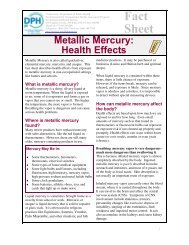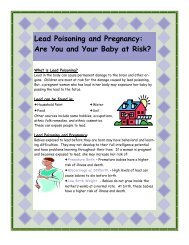Connecticut department of public health compliance guide for - CT.gov
Connecticut department of public health compliance guide for - CT.gov
Connecticut department of public health compliance guide for - CT.gov
You also want an ePaper? Increase the reach of your titles
YUMPU automatically turns print PDFs into web optimized ePapers that Google loves.
PLUMBING<br />
33. Location, installation, maintenance (1 demerit)<br />
a. All plumbing shall be sized, installed, and maintained in accordance with applicable state and<br />
local plumbing laws, ordinances, and regulations.<br />
b. Grease traps shall not be required, except in special cases as may be determined by the <strong>health</strong><br />
authority.<br />
c. The piping <strong>of</strong> any nonpotable water system shall be adequately and durably identified, such as by<br />
distinctive yellow-colored paint, so that it is readily distinguished from piping which carries<br />
potable water; and such piping shall not be connected to equipment or have outlets in the foodpreparation<br />
area.<br />
Public Health Code Regulations 19-13-B42 (f); 19-13-B45<br />
34. No cross connection, back siphonage, backflow (4 demerits)<br />
a. The potable water-supply piping shall not be directly connected with any nonpotable water-supply<br />
system whereby the nonpotable water can be drawn or discharged into the potable water-supply<br />
system.<br />
b. The potable water system shall be installed in such a manner so as to preclude the possibility <strong>of</strong><br />
backsiphonage.<br />
c. Indirect waste connections shall be provided <strong>for</strong> drains, overflows, or relief vents from the watersupply<br />
system.<br />
d. Dishwashing machines, refrigerators, steam kettles, potato peelers, and similar types <strong>of</strong> enclosed<br />
equipment in which food, portable equipment, or utensils are placed, shall not be directly<br />
connected to the drainage system. Each waste pipe from such equipment shall discharge into an<br />
open, accessible, individual waste sink, floor drain, or other suitable fixture which is properly<br />
trapped and vented: Provided, that, when a dishwashing machine is located adjacent to a floor<br />
drain, the waste from the dishwashing machine may be connected direct on the inlet side <strong>of</strong> the<br />
floor drain trap. Indirect connections <strong>of</strong> drain lines from other equipment used in the preparation<br />
<strong>of</strong> food or washing <strong>of</strong> equipment and utensils may be required by the <strong>health</strong> authority when, in his<br />
opinion, the installation is such that backflow <strong>of</strong> sewage is likely to occur. Each walk-in<br />
refrigerator equipped with a floor drain, shall have it so installed as to preclude the backflow <strong>of</strong><br />
sewage into the refrigerator.<br />
e. Indirect waste lines from dishwashers do not conflict with the plumbing code. The dishwasher<br />
must be properly trapped.<br />
Public Health Code Regulations 19-13-B37; 19-13-B42 (f); 19-13-B45<br />
30



